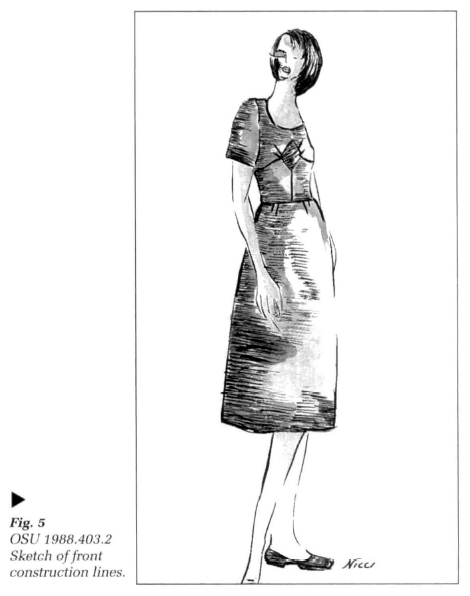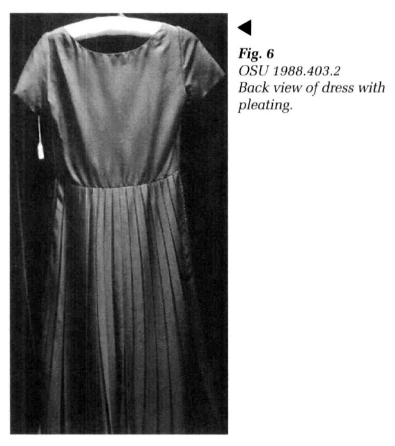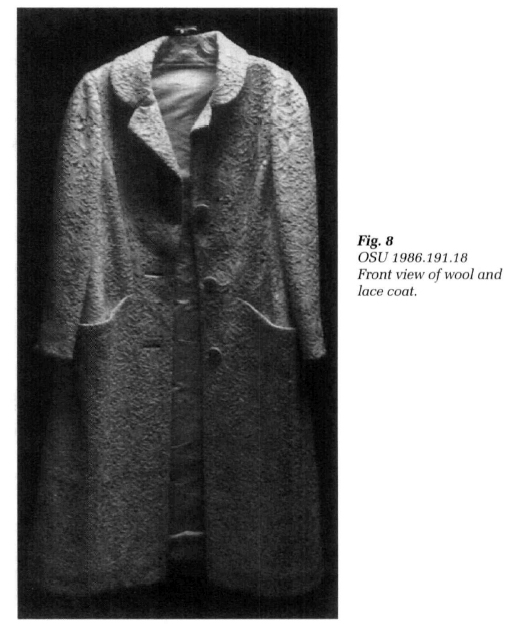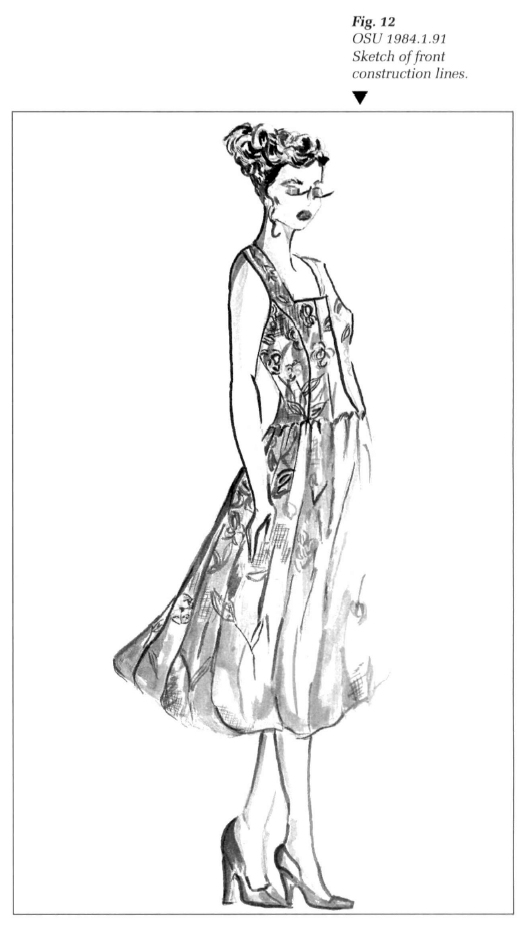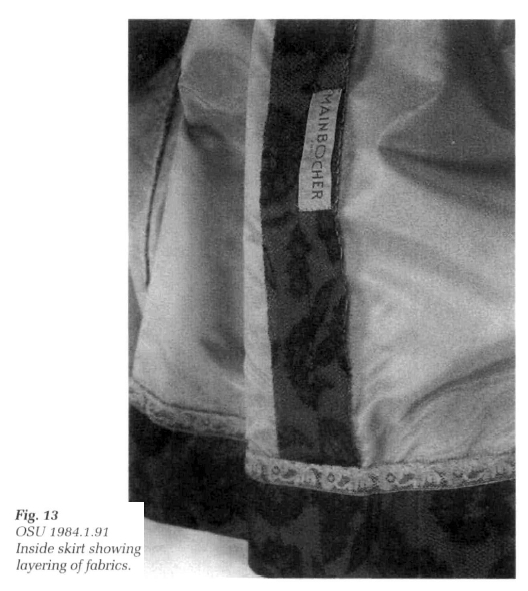Articles
Mainbocher — A Couturier's Contribution to Material Culture
Abstract
Among the various organizations for the production of wearing apparel within a techno-logically developed nation, the house of couture, in the Parisian sense, is unique. Mainbocher, the only American who owned a Parisian couture house, is the subject of a study of clothing and its relationships to the society in which the designer produced. A couturier or dressmaker/ tailor is an individual whose most recent designs are presented in several collections per year and then produced mostly on an individual basis for specific clients. Mainbocher's design philosophy and procedures of production obviously met a particular need for his clients. This paper investigates this phenomenon from a material culture perspective by studying not only the artifact and its characteristics, but also the symbolic nature of that artifact and what it communicates to society through its production and use by the upper-upper class clients of Mainbocher (though Mainbocher had clients from the theatre for personal and stage costume). Actual garments from two university costume collections were utilized for the study.
Résumé
La maison de couture, au sens parisien du terme, est unique en son genre parmi les organisations productrices de vêtements des pays développés. Mainbocher, le seul Américain à avoir possédé une maison de couture à Paris, fait l'objet d'une étude sur le vêtement et ses rapports avec la société pour laquelle il a été créé. Le couturier est la personne qui présente chaque année plusieurs collections de ses plus récentes créations et dont la production est surtout destinée à des clients particuliers. De toute évidence, Mainbocher avait une conception de la mode et des procédés de fabrication qui répondaient aux besoins spécifiques de sa clientèle. Dans le présent document, les auteurs étudient ce phénomène du point de vue de la culture matérielle en examinant non seulement l'arte-fact dans toutes ses caractéristiques, mais aussi ce qu'il symbolise et le message qu'il transmet à la société, à travers les étapes de sa production et l'utilisation qu'en faisait la clientèle de la haute société (bien que Mainbocher ait eu aussi des clients dans le monde du théâtre, qui faisaient appel à ses services pour leurs besoins personnels et pour la confection de costumes). Aux fins de l'étude, les auteurs se sont servis de vêtements provenant des collections de costumes de deux universités.
Introduction
1 Clothing significantly influences how we contribute to our cultural environment and society. It influences the way we interact with other people as it defines social, economic, and at times educational levels. It mediates the way we contribute to the cultural environment and the larger society in which we live. Throughout our lives on a daily basis we are exposed to a variety of clothing or apparel styles composed, either consciously or unconsciously, by individuals to facilitate their behavior within their societal roles.
2 Apparel styles are produced by special organizations in society, including manufacturers who mass-produce ready-to-wear apparel, manufacturers who produce designer label merchandise of a more limited supply and higher price points, and finally couturiers who design collections for the custom or individual client. Mainbocher, a couturier, started his business in Paris in the late twenties and moved his design house to New York City during World War II.
3 The purpose of this paper is to investigate the contributions to Western material culture of a unique couturier — Mainbocher — by examining briefly his salon organization, media supervision and the interrelationship of fabrication to the total design. Material culture may be defined as the material equipment of human existence (artifacts) alone or as artifacts and their intangible and cultural context. With the rise of interest in the field of symbolism, researchers are exploring the uses of material culture as a medium of visual communication.
4 Semiotics, or the study of how cultural meanings are produced and conveyed, has contributed to a renewed interest in culture and heritage. This approach focuses on expressive culture, or the artifacts and cultural products that include clothing fashions. Mainbocher's ideology of fashion is evident and is reflected in his work. To a great extent Mainbocher emphasizes his principal beliefs, values, and cultural messages through his clothing creations.
Theoretical Perspective
5 Recently the change in perspective for artifacts and technologies has been to view them as a functional part of social behavior. This purpose-oriented approach in anthropology began with the work of Malinowski and Good-enough.1 Artifacts are made for a certain use and definite purpose. They are part of a system by which messages are conveyed in a society. While not all uses of material culture in a society are necessarily communicative, it is well established that dress and its component parts are.2 The premises of symbolic interaction theory are that (1) actions toward objects are based upon meanings; (2) meanings are social products, socially derived and constructed; and (3) interpretative processes affect meanings. Symbolic interaction theory has been a major theoretical perspective for studying clothing behavior.3 Clothing has meaning, it is structured both internally and in relation to other objects, and it is employed with an effect on the physical environment and on social interaction. While all clothing has these qualities, the dress of women of the upper social strata is consciously planned for its semiotic qualities of communication and social effect. These are the women who employ custom designers like Mainbocher.
6 The women who approached Mainbocher to design for them wanted their clothing to reflect their position and roles in the society, and part of that reflection was the image of elegance and chic restraint. Other designers at the time offered clothing that could suggest the economics of the women's position, but they varied in the definition of current style. Mainbocher's clients have been characterized as "the perfectly groomed woman of distinction and strong character."4 Dale McConathy details many of these clients in his discussion of Mainbocher in the edited volume, American Fashion. His most famous client was the Duchess of Windsor, Wallis Simpson, who chose Mainbocher to design her wedding trousseau, though she had previously been dressed by Schiaparelli.
7 Mainbocher understood the value of publicity and always expressed his fashion philosophy in a quotable form. Mainbocher always wrote his own press releases associated with the showings of his collections, which Vogue describes as being "lucid and articulate."5 Since he had coverage in fashion publications and an explicitly stated design philosophy, women could choose his name and designs and be sure to express their personality and the role image they desired for their social interaction. That Mainbocher was able to be successful entirely from the made-to-order business in the United States, where others could not, attests to the very important role in social communication that he held. His contemporaries in American design, such as Norell and Trigère, worked on a wholesale, ready-to-wear basis.
8 The majority of women who contracted Mainbocher were of the upper-upper class of society. While movement upward is possible between other social classes, to be a part of this class one most generally had to be born into it. Barber and Lobel6 conducted research to understand the social differentiation in dress between the upper-upper class and the lower-upper class. In the United States "old money" families typically were associated with British styles of dress, such as tweeds and classic woolens, rather than French styles, which were associated with high fashion. Traditionally, upper-upper class individuals have on the whole not been concerned with "fashion" per se. Fashion following has been the vehicle for lower classes to facilitate social mobility and the vehicle for the nouveau riche to display their wealth in a most obvious way as they move upward.7
Research Focus and Methodology
9 The overall focus of the research is on Mainbocher's design characteristics and their reflection of the social environment of the times. This paper presents a smaller segment of information from a larger study. The total research project was guided by four foci. First was to study the background training and organization of Mainbocher's couture salons and business practices. Second was to study the orientation of the grain of the fabric in relation to the body and to garment parts for fitting body contours. The third area of interest was the special and unique methods of interior construction to achieve the outside silhouette. Finally, the interrelationship of fabrication to the total design was studied for the total message conveyed. The first and the last are the main focus of this paper. Before performing actual garment analyses, the researchers compiled background information about the training and work of Mainbocher, including who his clients were and for what features he was known. While his business records and Dennis Pollard's drawings of the models are housed at the Metropolitan Art Museum, these were not available for study due to the renovation of the galleries, which are located between the Costume Institute and the Irene Lewisohn Costume Reference Library.
Limitations of the Study
10 This study of Mainbocher garments was initiated to use the Textiles and Clothing Costume Collection at The University of Texas at Austin (UT) for faculty research to illustrate its potential for data.8 The examples presented are the result of chance occurrence and do not necessarily represent the designer's best work or greatest examples. But they do illustrate the genius of inner construction and the "truth" of his design philosophy. The addition of garments from the Ohio State University collection allowed the comparison of two collections to see how representative the UT collection was. The garments came into both collections as a result of individual donors/owners' presenting them to a university collection for use as reference material by students and faculty. The Ohio State University collection contains a wider range of Mainbocher's designing career, from the Paris thirties to the New York sixties (Table 1).
11 Although a study of garments from other museums is planned, the present study uses the two collections most accessible to the researchers. A total of twelve garments were available for examination by the researchers. From these garments, salient features about Mainbocher's work could be determined. In the use of the university costume collections, which usually depend upon donations rather than planned purchases to create the collection, this survey found that the garments represented the features credited to Mainbocher by fashion commentators. Of the three major classifications set up by the researchers on the basis of readings about his work, the two collections exhibited examples from each category. The examples with innovative use of fabrication have been elaborated on in this paper, but examples of changing traditional silhouettes and lengths for garments and modifications of contemporary construction methods also were found. University collections can be fertile ground for research.
Mainbocher
12 Mainbocher started a design house in Paris, France, in the 1930s when only Paris was recognized as the fashion capital of the world.9 He then made the transition to design in New York City, a fashion upstart in the world's eyes. He raised the standard of American couture as he "encouraged designers to look to their own heritage rather than try to follow trends abroad."10 His promotion of American couture contributed to American fashion, a subculture that diverges from a larger culture, with an emphasis on American society and social relations. At the time he returned from abroad to open his New York salon, other young American designers were endeavoring to create an American design business. Collectively, American designers developed their own style and looked toward the youthful fashion of the Midwest, gaining inspiration from "workaday garb" and from "Mexican peasant costumes."11
13 Mainbocher's philosophical contribution to couture can be demonstrated by his concern with the enduring qualities of fashion and not with the ephemeral nature of fashion.12 When Claire Price commented that fashion was ephemeral in nature, Mainbocher replied: "But fashion is not ephemeral — not real fashion. There are real fashions and false fashions. A real fashion is decidedly not ephemeral. It is so hard to find that it has almost a seven year life. It appeals to a very few at first, but during the later years of its life it refuses to be given up because it is too becoming or too comfortable or because it does any one of a number of things that fashion has to do."13 In his designs, he avoided gimmicky and exaggerated details, which he felt were tiresome and quickly dated. Mainbocher believed that "subtlety is another and more lasting message."14 His philosophical contribution to couture was evident when women returned to the salon to have dresses copied that they had been wearing for twenty or thirty years.15 Mainbocher was an advocate of style and elegance who saw "his work in terms of musical development, a restatement of themes, closely related."16 Others have praised him for his "chic, understated clothes."17 When queried as to his ideal woman in 1963, Mainbocher replied that it was "difficult because it involves the use of words that have become such naughty words — quiet elegance, a lady-like quality, and a certain serenity, especially for evening clothes."18 Elegance, simplicity, classicism were the watchwords of his designs.19
14 Mainbocher saw himself as a "couturier" or dressmaker/tailor (which is the literal translation of the word couturier) who would "dress women as ladies;" he did not see himself as a "designer," a term he viewed as relating to mass production and the visual and plastic ideas of mass culture.20 He believed that "femininity was epitomized by the lost grandeur of the eighteen-seventies, eighties and nineties,"21 but, unlike other early twentieth-century Parisian designers who had a similar view, his creations were appropriate for the new lifestyles of the twentieth century. Similar to his distinction between the terms couturier and designer, Mainbocher developed a sense of his own exclusivity in that new clients had to be recommended by current or former clients. Serious clients knew the etiquette of fitting sessions. The aura of Mainbocher was maintained and may be viewed as snobbery as illustrated when one of the vendeuse turned away Gloria Vanderbilt because she wore stirrup pants to the salon. For those who came to view his collection, Mainbocher was the first to impose a caution, or guarantee of purchase that was equal to the amount of the cheapest dress in the collection. This custom was initiated to bar the copiers and tourists.22 He, unlike contemporary designers, did not believe in the lucrative practise of endorsing other product lines such as bags, shoes, or hosiery. He did, however, have a perfume, White Garden, that was sold in his maison de couture, a tradition started by the designers of Paris during the twenties, beginning with Chanel.
15 For his upper-class clients Mainbocher's was the place to go for clothes that were perfectly appropriate as he combined restraint and practicality with the most magnificent materials.23 As Mainbocher explained it: "There's a magic and mystery about being right... Fashion should appear effortless — like beautiful singing — you shouldn't share the scaffolding with people, but you have to put the dress in focus three ways ... three beings of every costume — tranquil, moving, sitting. You can't wear a sketch."24 Since fabric was the source of inspiration for his designs, he began an innovative approach to fabric selection. He would ask fabric houses for fabrics not shown in their samples, which at the time was not the usual procedure.25 Today many designers routinely design their own fabrics and have mills produce them. Mainbocher also was unusual in his method of payment for fabrics. He did not pay for them until they were actually used in the collection. Upon closure of his New York salon in 1971, there was an extensive inventory of fabrics for which payment had not been made.
16 His contribution to couture from the textile side was unique. He used men's shirtings, linen towelling, and cotton piqué for floor-length dresses or evening coats; additionally, he was well known for his novel use of batiste, voile, organdy, piqué, linen, embroidered muslin, and gingham.26 He used gingham, a common everyday fabric, as it had not been used before, elevating it to upper social occasions. His use of gingham can be compared to the transformation of denim in the 1960s from a work/jean fabric to a fashion fabric. Mainbocher was a significant user of embroidered fabrics and thus revived a dying industry. He also had great expertise when it came to crepe fabrics. According to Mrs. Alfred G. Vanderbilt, one of his clients, "He does marvellous things with crepe, that is his forte; no one knows how to drape it die way he does. His crepes have a sinuous quality, a seductive quality."27 His silk crepes have been described as flowing easily over die body, emphasizing the grace and freedom of the figure.28 He was also known as "a master of twisted and draped fabric."29 During World War n he showed creativity in his designs when fabrics and other resources were limited by conservation legislation.
17 His innovations from the couture perspective can be classified as (1) innovative use of fabrics for traditional categories, (2) changing traditional silhouettes or lengths for garments, or (3) modifications of current construction techniques. The first category can be illustrated by his being the first to costume-dye furs in 1949 with the first black mink coat and his famous beaded evening sweaters (cashmere cardigans with clusters of beads, introduced during World War II to provide comfort to his clients during cold winters). Changes of the traditional silhouette involved bare-armed blouses for suits, man-tailored dinner suits, bows instead of hats, the evening version of the "tennis dress" (a white evening dress with V neck and stole), revival of the crinoline, the rain suit, and sleeveless dresses with matching jackets, and short evening dresses in 1946 as a response to the difficulties associated with getting in and out of motorized vehicles.30 Mainbocher came to couture in the early thirties and added a "new dimension to the style by putting extra padding at the top, and deepening the armhole so that the sleeve fell straight and wide from a broad shoulder: a silhouette very characteristic of the 1940s."31 Another innovation that presaged postwar styling was his three-quarter length, half-belted jacket with a bloused back, which he designed in 1937.32 New construction techniques included the waist cinch; simple dresses with tie-ons, such as skirt-like aprons or apron skirts worn with modish shorts or long pants; sari evening dress; the "bump" shoulder-modified leg-of-mutton sleeve on suits and coats; peter pan collared dressmaker suits; and sleeveless dresses with matching jackets.33
18 "Perhaps his biggest achievement was his concept of the basic black dress, which was varied by flowers, peplums and overskirts."34 In 1934, he introduced the first strapless evening dress in black satin. He used old-fashioned boning techniques that did not catch on until later in the decade.35 He "is said to have had his first success with the introduction of strapless styles for evening wear,"36 even though Chanel retained them most consistently throughout the thirties.
19 Having worked for Harper's Bazaar and Paris Vogue for a total of nine years as editor, Mainbocher was aware of the importance of clothing as a medium in communicating messages. As editor, Mainbocher would be responsible for determining the newest and most significant images from the designer collections and presenting them in a form that would excite and entice the public to invest in those designs. In the presentation of his work he never allowed his models to be shown on the same page with those of other designers. According to Kaiser, material culture is involved in sending messages that have meaning or significance for individuals in everyday contexts.37 People themselves are involved in the process of creation or interpretation of the messages received, and this interpretation is performed on a continual basis. Each organization and group within a given culture has a common set of shared artifacts and understandings. The organization shares the common values with its members. Clothing can serve as a medium in transmitting such common values and shared understandings among organizations and groups of people. In this manner, domes act as a form of appearance communication. A uniform is a good example of appearance communication and is an integral part of the organizational culture. As a designer, Mainbocher realized this important concept of organizational culture when he designed uniforms for the Women's Auxiliary of the Marine Corps (WAVES), American Red Cross (SPARS), and the Girl Scouts, the latter of which were still in use as late as 1985.38 Devlin has commented that "the cut and style of many American uniforms, like Mainbocher's designs for the WAVES, were the envy of European services."39
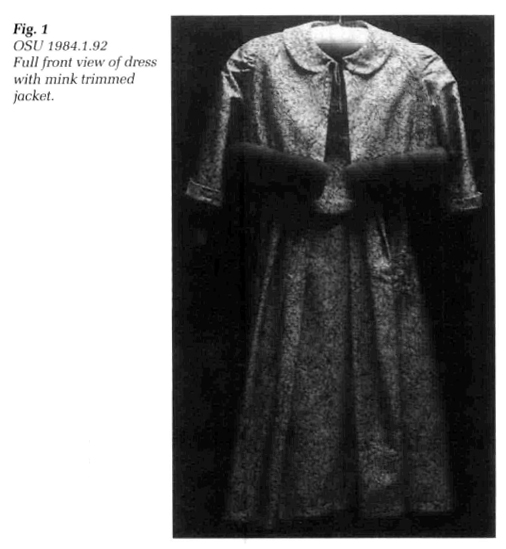 Display large image of Figure 1
Display large image of Figure 1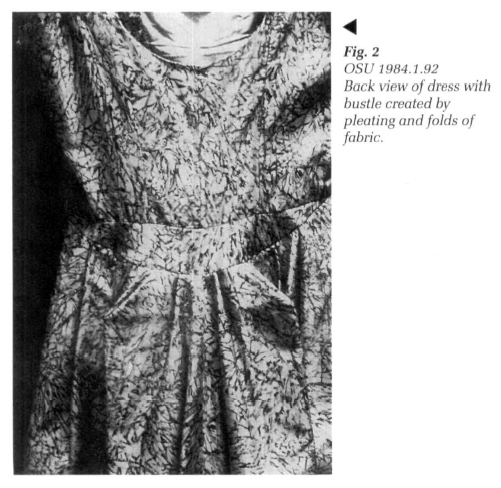 Display large image of Figure 2
Display large image of Figure 2Interrelationship of Fabrication to the Total Design
20 It is beyond the scope of this report to consider garments from all three categories of Mainbocher's unique design contributions. For this paper, only garments that display innovative treatment in fabrication for traditional categories are discussed.
21 Several garments in the two collections were examples of the short length evening or cocktail dresses with matching jackets for which Mainbocher was known. The OSU 1984.1.92 example was of green-tone printed silk shantung with the jacket of the same cloth trimmed in mink at the waist (Fig. 1). The silhouette of this garment is very interesting since it has a bustle effect in the back skirt. The 1950s decade was the period predicted for back fullness in the silhouette in the studies of the cyclic nature of fashion by Kroeber, Richardson and Kroeber, and Young.40 By and large the bustle effect did not reach the predominance of the previous occurrences, but both Balanciagia (another prestigious Paris-based designer) and Mainbocher showed restrained examples suitable for the contemporary living style.
22 This silk shantung bustle is designed with folds of fabric falling from an inset yoke at the end of the back bodice (Fig. 2). Most of the fullness comes from pleats symmetrically placed on both sides of centre back, but the new form is the complete loop of fabric that falls free from the yoke a short distance from centre back. The front of the dress has a central panel that is reminiscent of the stomacher of gowns of the eighteenth century, including the bow knots or eschelles decoration that was so ubiquitous for them (Fig. 3) Unlike the eighteenth-century version, which was laced or hooked to the front of the bodice, this one is permanently seamed to the bodice at the shoulder princess line, and only the rounded waist tab is floating loose over the waistline (Fig. 4).
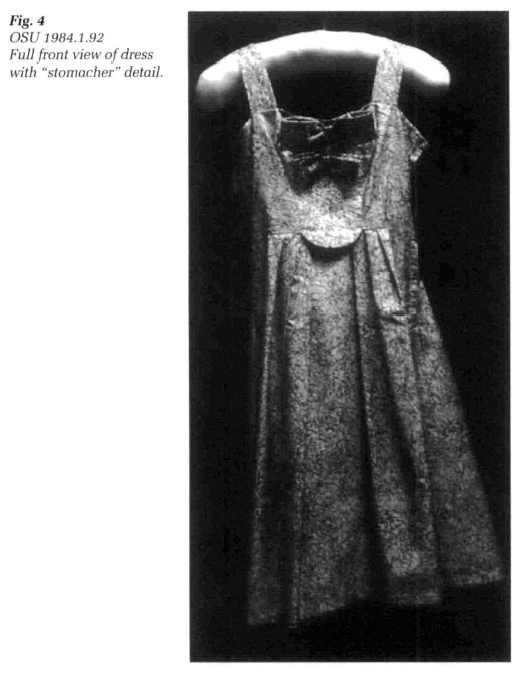 Display large image of Figure 4
Display large image of Figure 423 From today's perspective the pairing of the mink fur with the green printed shantung may not seem pleasing. Yet, the mink definitely symbolized status in the 1950s, when mink stoles were frequently worn around the neckline and shoulders of suits for daytime formal occasions. Mink on the jacket similarly signals status when fewer people were able to afford mink. Few other furs could convey such status except ermine. The bows-and-stomacher effect is feminine, but also subtly refers to the eighteenth century French court dress of Madame Pompadour, where it was almost a uniform requirement, tempered by twentieth-century minimalism.
24 A second dress with a bustle effect is OSU 1988.403.2, of navy blue faille in silk. The dress is sleeved with short sleeves and appears quite simple from the front. A square of 7 cm is inserted at the bust level, centre front. The grain of the square is rotated 45 degrees to set the ridges of the faille in contrast to the rest of the bodice (Fig. 5). From the front the skirt is a plain straight skirt, yet the skirt is finely pleated across the back with radiating pleats (Fig. 6). On top of this pleated area of the skirt an apron is designed to be worn with open ends to the back like a traditional apron. The apron is pleated with inverted box and knife pleats across the front, with the back edges cascading in ripple to the hemline. This styling moves the straight skirt to the fuller skirt silhouette (Fig. 7).
25 The subtle message of this garment depends on the solid colouration and the ribs of the faille fabric. If the fabric did not have the ridges of the rib weave but instead had a plain surface, the effect would be quite different. The rotation of the ribs allows for a subtle change in texture for a design focal point. The radiating pleats revealed under a cascade of supple fabric allow for a mixed geometric and sensuous message. This is a classic example of Mainbocher's philosophy that subtlety is a lasting message.
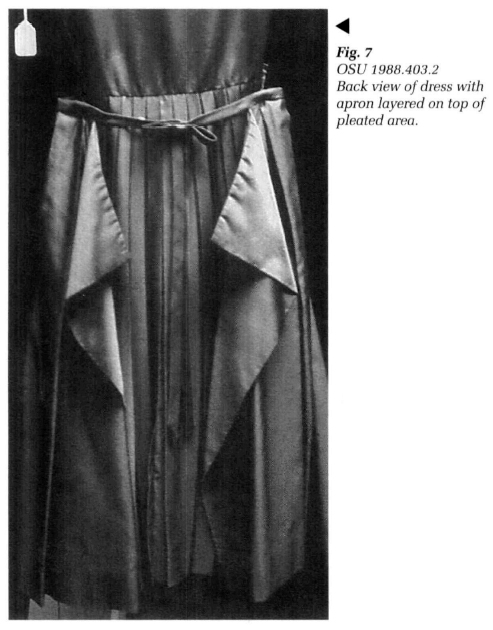 Display large image of Figure 7
Display large image of Figure 7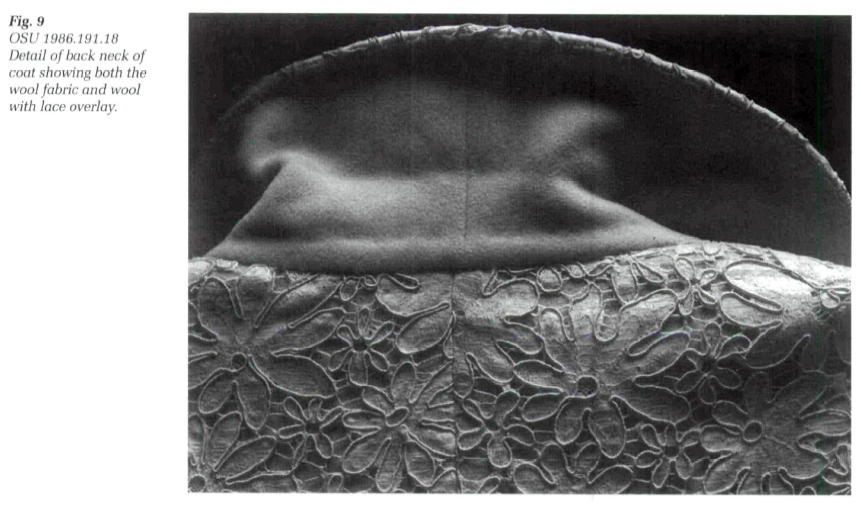 Display large image of Figure 9
Display large image of Figure 9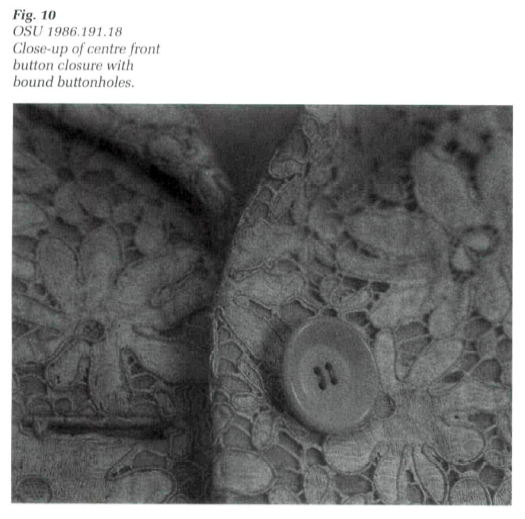 Display large image of Figure 10
Display large image of Figure 1026 A unique pairing of fabrics was found in a 1950s evening coat (OSU 1986.191.18) (Fig. 8). An almost blanket-weight beige wool flannel was covered by a cream Alençon lace, which moves the coat from day wear to formal evening wear (Fig. 9). For some fitting areas darts were made in the heavier wool but not in the lace, due to its inherent suppleness. Buttonholes were bound with the double layering of wool and lace, no mean feat of construction (Fig. 10). The collar was a tailored notched style with smaller, higher lapels than today's. Because of the difficulty of easing heavyweight fabric like the wool flannel in preparing the sleeve cap, the sleeve was divided into two sections with the equivalent of a dart at the top edges to create the shape for the end of the shoulder bulge. The armsceye princess line for fitting the bust and waist terminated in slanted hip pockets. Silk taffeta lining stabilized the coat better than a lighter weight lining by providing body complementary to the weight of the outer layers and imparting a sound as the fabric is brushed in wearing, that only silk taffeta can make. This effect had long been associated with upper class costume behavior since the 1800s. Anton Chekov used this audible feature of silk taffeta as a descriptive aspect of the characterization of the female antagonist in the play, The Bear. Additionally this use of crisp silk taffeta lining that makes the rustling sound in movement was typical of couture in the period.
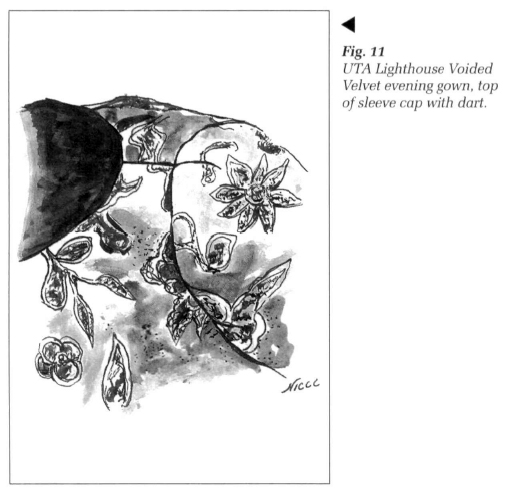 Display large image of Figure 11
Display large image of Figure 1127 The interrelationship of the fabrication to the total design can be seen in the striking combination of two entirely different fabrics in hand, weight, and construction to create a synergism that results in the design being transformed from day wear to formal evening wear that requires a presence of elegance. The fabrication created the need for unique construction techniques to implement the design such as the shaped seam at the sleeve cap. In the UTA Lighthouse gown Mainbocher used only a dart at the top of the sleeve to allow the bulky fabric to fit the armhole instead of using easing, while the seam technique of the lace coat would cause more disruption of the fabric pattern (Fig. 11). The standard treatment of buttonholes in couture is the bound buttonhole. It requires great skill to do well and that it could be done with the lace/wool combination is a quiet message of superior workmanship. The selection of the silk taffeta for the lining not only stabilized the garment, but also created an overall effect noticeable upon movement.
28 A more subtle fabrication was the black tulle overlay on black Chantilly lace backed by cream silk taffeta for a sleeveless cocktail dress from the 1950s (OSU 1984.1.91) (Fig. 12). The tulle overlay does not provide a highly visible effect, yet it does change how light is reflected from the surface of the lace and taffeta combination (Fig. 13). The dress is not ingenious in the design, for the shoulder princess style with a squared neckline and full pleated skirt had been used previously. What is different is the fabrication. The lace creates an image of softness and grace without calling attention to itself, but not as soft as if it were unlined. The style would allow embellishment by jewelry without the dress competing for interest.
29 The fabrication in the tulle, lace, and taffeta dress helps the design to make a subtle statement or message. Again, a synergism is created by combining the three fabrics. The lace sends a message of softness and grace. The interaction of the three fabrics softens the overall light reflectance and changes the message from stark to subtle with an air of elegance. The fabrication does not detract from the design, but rather works as an integral part of the design. Lace has always been associated with privilege and a refined manner. Black lace rather than blonde has the association of mystery and sexual innuendo. So while the design styling is almost little-girlish, the lace moves the message to the quiet adult.
30 Formal evening wear was represented by a full-length blue silk chiffon skirted and beribboned bodice of metallic and silk (OSU 1988.433.3). The natural-waisted bodice is fitted and basically constructed like a strapless gown. Two small 0.9 cm wide lined strips of the border motif of the wider paisley ribbon are used for straps, but not really of a design to support the bodice hilly. Set is also maintained by a grosgrain ribbon waist-stay secured to the bodice. Three widths of ribbon compose the bodice (Fig. 14). In the back the ribbons are placed edge to edge, and as they move to the front, they separate to define the bust by one ribbon remaining at waist level and the other two criss-crossing at centre front. Where the ribbons diverge, the blue silk chiffon of the skirt fills the voids. The back fullness effect of the gown outer skirt is produced as the full width of 177 cm of fabric is tightly gathered to fit a space of 9 cm on one side of the centre back zipper (Fig. 15). In front, panels functioning like godets introduce volume at the hemline. Godets are triangular pieces of fabric inserted into a straight seam or slit to add flare. In this case the side of the godets are the same side of the fabric piece (selvage or loom finished edge), thus giving a full 180 degree arc of volume instead of the more usual triangles, measuring fractions less than 90 degrees of the arc. The under-skirt has the crepe side of satin-back crepe fabric facing the underside of the chiffon. Thus the interior shimmers of matching blue satin. The volume introduced in the chiffon outer skirt is controlled by making the underskirt of smaller dimensions, with only two box pleats at the locations of the godet-like panels of the overskirt.
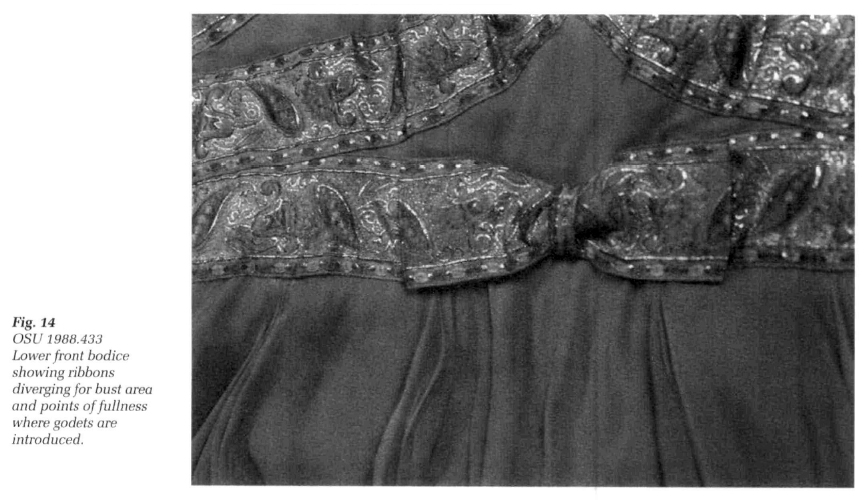 Display large image of Figure 14
Display large image of Figure 1431 The paisley motif of the ribbon was a contemporary usage or motif resulting from the resurgence of Indian influence in philosophy and other social aspects: Nehru collars, Sidhartha, and Indian textiles for evening coats for both men and women. The metallic/gold content of the ribbon certainly visually emphasizes the wealth of the garment, yet is restrained by being only part of the bodice. Its jewel-like surface would blend well with actual jewels worn for formal occasions. The dress does not overwhelm the wearer — it would allow the personality and appearance of the wearer to be supreme. The back fullness would enhance the movement of the wearer by training out, allowing for a subtle yet dramatic entrance like Loretta Young's entrance at the opening of her television programme of the late fifties. The application of the ribbon fabric in the bodice is a vital part of the total design, as it helps the overall garment communicate a message of wealth, elegance, and chic restraint. It is effective in making this statement without being gimmicky.
Discussion
32 It may be proposed that the behavior of Mainbocher that others describe as snobbery was really a purposeful manipulation of the situation to enhance the value of his clothes. Seriff, who explored the relationship between art patron and artist, has pointed out that the patron has power.41 The patron is in control nl the interactions and can visually do what he or she wills. It may be speculated that by introducing the controls of proper attire for admittance and the caution to keep out nonserious tourists and journalists who would publicize the styles without Mainbocher's guidance, Mainbocher was changing or at least balancing the power levels between his clients and himself. This behaviour also served to preserve the exclusiveness or scarcity of his work, a crucial factor for any item to be a status symbol.
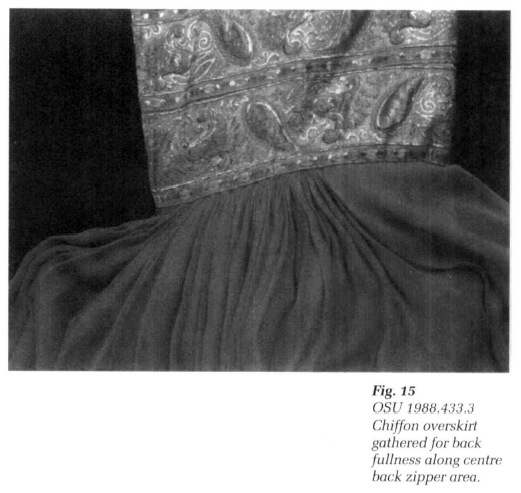 Display large image of Figure 15
Display large image of Figure 1533 Mainbocher designed for the American upper class or Old Guard or "old money." They could afford elegant clothes but generally mistrusted the "newness" of extreme high fashion or couture. They were not concerned with being in fashion competition because they were the top level. Mainbocher was a genius at scrutinizing fashion and distilling it to the essential elements, resulting from his earlier skills developed as a fashion editor. These elements were then synthesized into looks for the clientele who wished to be current vet suitable. As Mainbocher phrased it, "Fashion has many levels, there's the top of the stream, and then there's the deeper current that keeps on going. It's that deeper current, the positive underflow of fashion, that I'm concerned with."42 As the sixties merged into the seventies with the societal orientation to youth and the breaking of traditions, Mainbocher could be viewed as the fashion purist who tried to remain and retain the orientation of couture for the older, well-established tradition. His designs of the sixties evidenced the classicism of his 1930s work.
34 Mainbocher was unique in that he combined restraint and practicality using magnificent fabrics. His garments were designed for a well-established wealthy clientele who would not be classified as nouveaux riches. These were women who had strong identities and personalities and did not need to draw outward attention to themselves through their clothing. Rather they preferred refinement and subtlety. Additionally, the classic styling of Mainbocher garments allowed the fashions from the previous seasons or even years to be used, while lower levels of society constantly demanded the new to illustrate monetary prowess and social savoir faire.
35 Mainbocher's earlier experience as a fashion editor allowed him to use the press and to communicate his message of exclusivity. He would not allow his garments to be photographed and displayed with other work from his contemporaries. Many times he was given separate billing in the table of contents in Vogue and in Harper's Bazaar. Again this distinction would give Mainbocher's work privilege and provide the features of desirability and scarcity that are required of any item to be a status symbol.
36 In conclusion, Mainbocher's principal beliefs, values, and cultural messages were expressed through his work. He communicated these aspects of material culture not only through his use of the press and mechanics of his salon, but also through the interrelationship of fabrication to the total design of the garment. By creating synergisms with different fabrics and then using them as an integral part of the design, he became a master at using his work as a communicative tool within society. Thereby Mainbocher made a significant yet subtle contribution to our material culture.
Sincere appreciation is given to Mr. Charles Kleibacker for the use of garments from his personal collection on loan to The Ohio State University Collection as well as to Dr. Lucy R. Sibley, Chairman of the Department of Textiles and Apparel, which maintains The Ohio State University Collection. Appreciation also is given to Dr. Ardis M. Rewerts for assistance with The University of Texas at Austin Collection. Thank you is also extended to the three reviewers for their helpful comments.


